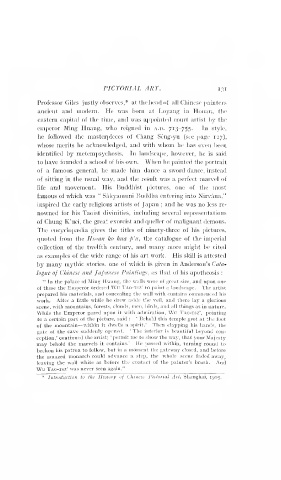Page 387 - Chinese Art, Vol II By Stephen W. Bushell
P. 387
PICTORIAL ART. 131
Professor Giles justly observes,* at the head of all Chinese painters
ancient and modern. He was born at Loyang in Honan, the
eastern capital of the time, and was appointed court artist by the
emperor Ming Huang, who reigned in a.d. 713-755. In style,
he followed the masterpieces of Chang Seng-yu (see page 127),
whose merits he acknowledged, and with whom he has even been
identified by metempsychosis. In landscape, however, he is said
to have founded a school of his own. When he painted the portrait
of a famous general, he made him dance a sword dance, instead
of sitting in the usual way, and the result was a perfect marvel of
life and movement. His Buddhist pictures, one of the most
famous of which was " Sakyamuni Buddha entering into Nirvana,"
inspired the early religious artists of Japan ; and he was no less re-
nowned for his Taoist divinities, including several representations
of Chung K'uei, the great e.xorcist and queller of malignant demons.
The encyclopaedia gives the titles of ninety-three of his pictures,
quoted from the Hsiian ho hua p'u, the catalogue of the imperial
collection of the twelfth century, and many more might be cited
as examples of the wide range of his art work. His skill is attested
by many mythic stories, one of which is given in Anderson's Cata-
logue of Chinese and Japanese Paintings, as that of his apotheosis :
" In the palace of Ming Hwang, the walls were of great size, and upon one
of these the Emperor ordered Wu Tao-tsz' to paint a landscape. The artist
prepared his materials, and concealing the wall with curtains commenced his
work. After a little while he drew aside the veil, and there lay a glorious
scene, with mountains, forests, clouds, men, birds, and all things as in nature.
While the Emperor gazed upon it with admiration, Wu Tao-tsz', pointing
to a certain part of the picture, said : ' Behold this temple grot at the foot
of the mountain—within it dwells a spirit.' Then clapping his hands, the
gate of the cave suddenly opened. ' The interior is beautiful beyond con-
ception,' continued the artist; ' permit me to show the way, that your Majesty
may behold the marvels it contains.' He passed within, turning round to
beckon his patron to follow, but in a moment the gateway closed, and before
the amazed monarch could advance a step, the whole scene faded away,
leaving the wall white as before the contact of the painter's brush. And
Wu Tao-tsz' was never seen again."
* Introduction to the History of Chinese Pictorial Art, Shanghai, 1905.

